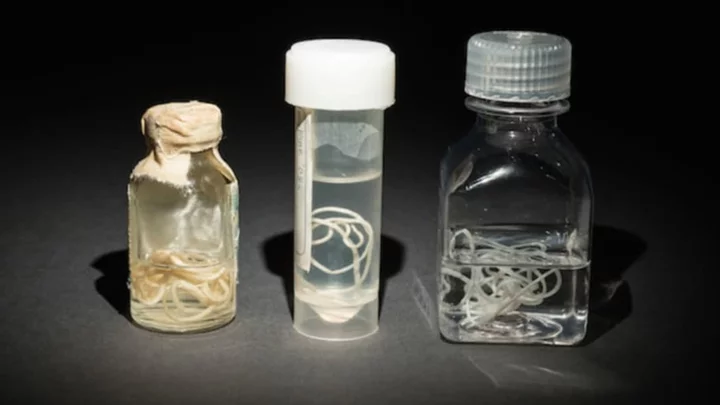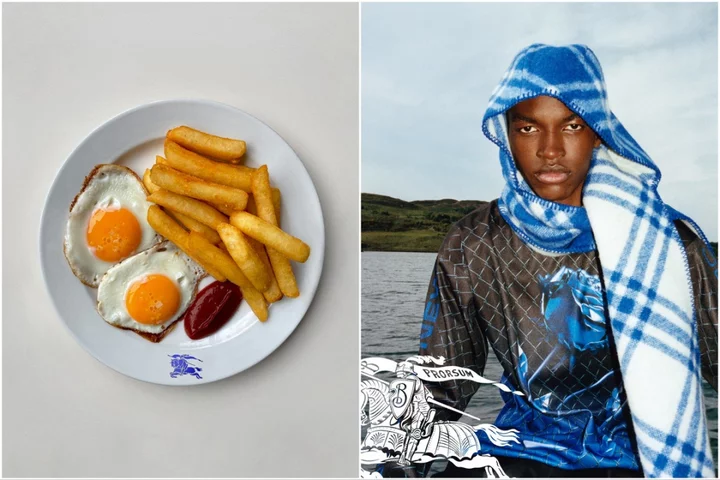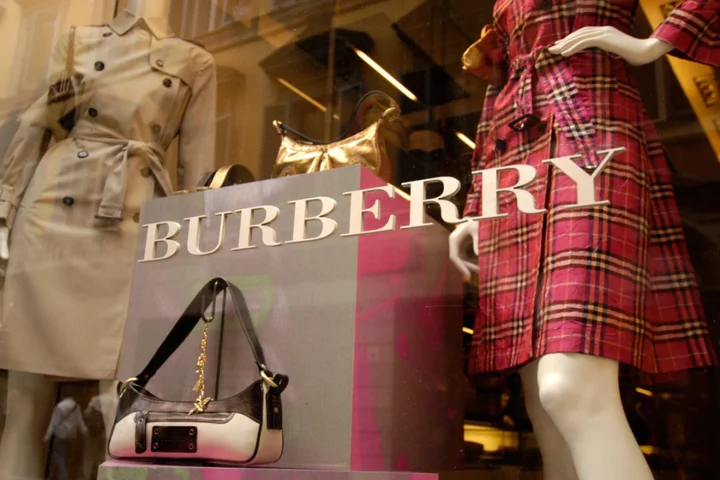
8 Mind-Blowing Facts About the Big Bang
The birth of our universe happened at least 13 billion years ago—and you may have seen it on TV.
2023-09-12 00:23

10 Facts About Guinea Worm Disease
Dracunculiasis, or Guinea worm disease is, by all accounts, pretty awful: A person with the disease hosts a parasitic worm that forms a painful blister under the skin that eventually bursts, allowing the worm to emerge and lay its eggs in water. Those afflicted don't just endure pain (although there's plenty of that); they also run the risk of secondary infection and permanent paralysis, and there are economic consequences to the disease, too.
2023-09-12 00:18

AC/DC reignite talk of world tour: ‘Dates are being looked at for next year!’
After years of talk the group could get back on the road together, AC/DC have reignited rumours of a world tour by being lined up to headline a major US music festival.
2023-09-11 23:54

Scientists reveal everyday pleasures that elevate brain performance
Have you got a favourite track? Well, it’s time to turn it up and enjoy the beat with a warm cup of coffee. Everyday pleasures like listening to music or sipping a cup of coffee can elevate brain activity, improving cognitive performance including in tasks demanding concentration and memory, according to a recent study. A group of researchers looked at a new NYU Tandon School of Engineering study involving MindWatch a brain-monitoring technology. MindWatch is an algorithm that analyses a person’s brain activity from data which is collected from a wearable device which can monitor electrodermal activity (EDA). EDA is a measure of electrical changes in the skin triggered by emotional stress, often associated with sweat responses. In the study, published in Nature Scientific Reports, participants were made to wear these skin-monitoring wristbands as well as brain-monitoring headbands to complete a range of cognitive tests. The tests were conducted while the participants listened to music, drank their coffee and smelled perfumes reflecting their individual preferences. These tests were completed again without any of those stimulants. Researchers found that both music and coffee significantly influenced participants’ brain arousal, and put them in a “state of mind” that could “modulate their performance in the working memory tasks they were performing,” the NYU press release says. The wearable device found that the stimulates specifically triggered increased “beta band” brain wave activity which is linked to peak cognitive performance. Perfumes also had a slight positive effect, suggesting to researchers that there is a need for further investigation. “The pandemic has impacted the mental well-being of many people across the globe and now more than ever, there is a need to seamlessly monitor the negative impact of everyday stressors on one’s cognitive function,” says Rose Faghih, an associate professor of biomedical engineering who developed MindWatch in six years. “Right now MindWatch is still under development, but our eventual goal is that it will contribute to technology that could allow any person to monitor his or her own brain cognitive arousal in real-time, detecting moments of acute stress or cognitive disengagement, for example. “At those times, MindWatch could ‘nudge’ a person towards simple and safe interventions — perhaps listening to music — so they could get themselves into a brain state in which they feel better and perform job or school tasks more successfully, professor Faghih added. The specific tests used in this study involved a working memory task, called the n-back test which involves presenting a sequence of stimuli to the participants, in this case, images or sounds. It was shown one by one, and people were asked to indicate whether the current stimulus matched the one presented "n" items back in the sequence. This study employed a 1-back test — the participant responded "yes" when the current stimulus is the same as the one presented one item back — and a more challenging 3-back test, asking the same for three items back. Three types of music were also tested out, there was energetic and relaxing music familiar to the participants, as well as novel AI-generated music that reflected the subject’s tastes. Results showed that familiar, energetic music led to the best performance, followed by AI-generated music tailored to the participant’s taste. Coffee and perfume had lesser but still noticeable positive impacts. The MindWatch team wish to conduct further experiments to confirm the tool’s reliability and understand the broader effectiveness of various interventions on brain activity. Researchers have noted that while specific interventions might generally boost brain performance, individual results may vary. The study is published in the journal Nature. Read More ‘The Puss in Boots Effect:’ Women use infant-directed speech when addressing dogs with larger eyes Study reveals one thing to focus on if you want to live to 100 Extreme heat may speed up cognitive decline for people from poorer neighbourhoods Quick, moist and flavourful: Jurgen Krauss’s marble cake Mother whose hot flushes led to leukaemia diagnosis says ‘don’t ignore’ symptoms What happens at a sexual health check-up?
2023-09-11 23:49

Watch: Michael Jordan Appears in a 1992 McDonald’s Employee Training Video
His Airness once lectured McDonald’s employees on good customer service: “They expect to be treated as a guest in your home.”
2023-09-11 23:16

Breakfast at Burberry’s: Fashion house launches collaboration with London café
Burberry has launched a project designed to mix British luxury with everyday life – and it’ll all start with their take on the most important meal of the day. The heritage fashion house has announced a new initiative, Burberry Streets, which will see the brand take a more prominent place within a selection of cities. Through experiences, installations and events across cities such as London, Seoul and Shanghai, Burberry will showcase signature elements of the brand, such as the seasonal check pattern in knight blue, rose print, and the newly redefined Equestrian Knight Design. In London, the Burberry Streets takeover will begin with the brand having a major presence in Norman’s Cafe, a restaurant in Archway that serves all-day breakfast food, as well as sandwiches. As part of London Fashion Week, which runs from 15 to 19 September, a travelling Norman’s food truck will make appearances on The Strand and Duke of York Square. The food establishment shared news of the collaboration with a post on social media on Monday (11 September). Alongside an image of a meal of two fried eggs and chunky chips, on a plate branded with the Burberry logo in blue, the straightforward caption reads: “2 eggs & chips. @burberry will be taking over Norman’s cafe for London fashion week, Wednesday to Sunday.” In response, fans of both the brand and the restaurant voiced their approval for the impending linkup. “Name a more iconic duo I’ll wait!” reads one supportive comment, while another Instagram user deemed it “the Great British pairing”. Outside of the collaboration with Norman’s Cafe, Burberry Streets will incorporate symbols of the house in multiple locations across the capital. Flags featuring the new rose print will fly above Bond Street and Piccadilly’s screens will be lit up with videos from the Winter 2023 campaign. The Equestrian Knight will take to the streets in the form of chalk stencils on paths and in parks, while black cabs will be wrapped in Daniel Lee’s English rose print. Burberry Streets will land in Seoul and Shanghai in October. Lee’s first collection for the brand, Winter 2023, is available now. In a statement, Rod Manley, the Chief Marketing Officer of Burberry, shared the company’s anticipation for the designer’s work to reach buyers. “We are so excited to see Daniel’s first collection arriving in-store and online,” he said. “With our redesigned website, new brand signifiers across product and branding and the launch of our global Burberry Streets initiative here in our home market, we're looking forward to sharing the new Burberry world with our clients.” Read More How Burberry evolved from humble raincoat maker to luxury fashion giant Kate Middleton re-wears Alexander McQueen suit to watch England beat Argentina in Rugby World Cup Kanye West’s ‘wife’ Bianca Censori uses pillow to cover nearly nude outfit in latest Italy controversy Secondhand September: The best places to buy pre-loved fashion online How Burberry evolved from humble raincoat maker to luxury fashion giant Kate Middleton re-wears Alexander McQueen suit to watch Rugby World Cup
2023-09-11 22:50

Why Can’t Vampires Eat Garlic?
The idea that garlic repels vampire has been linked to some serious health problems.
2023-09-11 21:17

8 Discontinued Halloween Candies You’ll Never Find in Your Trick-or-Treat Bucket Again
A lot of them had something to with candy corn.
2023-09-11 20:20

Mother says ‘don’t ignore’ symptoms after persistent hot flushes led to leukaemia diagnosis
A mother who felt she was being “eaten away” after hot flushes led to an incurable blood cancer diagnosis in her late 50s has urged women not to ignore symptoms. In the summer of 2022, Barbara Geraghty-Whitehead, 58, a school inclusion manager who lives in Cheshire, began to experience hot flushes, dizziness and she developed an ear infection. She said she “put it to the back of (her) mind”, but her symptoms persisted – and eventually, after months of hesitation, she visited her GP in September 2022 and underwent blood tests. Within a matter of hours, she received a phone call from her doctor, saying that they were concerned about how high her white blood cells were and that they suspected it could be cancer. One week later, after further tests, Geraghty-Whitehead was told she has chronic myeloid leukaemia (CML) and it is incurable. “You say you want to carry on as much as normal, but from that second nothing else was going to be normal anymore,” she told PA Real Life. “I wanted to go in and for them to say, ‘No, it was a mistake, it’s something else,’ but they didn’t, they said it was CML.” Geraghty-Whitehead started taking chemotherapy tablets that same day – and despite experiencing side effects of fatigue, nausea, acid reflux, and a loss of taste, nearly one year later she has responded well to treatment and has been able to see her daughter get married in Cyprus. After nearly ignoring her own symptoms, she wants to encourage others not to “make excuses”, as “people need to know the signs so they can get diagnosed early”. “When I was first diagnosed, you don’t know where to start and that in itself is overwhelming, but the support I’ve received has been fantastic,” Geraghty-Whitehead said. “I think about [my diagnosis] every day and it is hard and I do get upset, but now I’ve just got to face the fact that this is the new me. “I’m never going to be the person that I was before but I’m going to recreate the new me.” Geraghty-Whitehead said she almost ignored her cancer symptoms and attributed her hot flushes to warm weather and “thought no more of it”. She said she did not think it was related to menopause, as she had already been taking hormone replacement therapy (HRT) patches for years to treat her bone pain. “I started not feeling right and I couldn’t figure out what it was, but I didn’t do anything about it – I just left it,” she explained. She added: “I never ever got hot flushes. Even though I was put on HRT patches, it was mainly for my bone pain, so I just put it to the back of my mind and I thought no more of it.” Looking back now, she realises she should have acted sooner – but on September 16, she visited her GP and underwent blood tests. Days later, on the day of the Queen’s funeral, she found herself sat in an empty hospital waiting room, preparing for further blood tests – and by the end of that week, on September 23, Geraghty-Whitehead received the news she has CML and the following minutes felt like “a blur”. “Everything happened so fast, it was just like a roller-coaster,” she said. “I think it was worse waiting for the blood test results because I didn’t know what type of cancer it was, whether I was going to live, whether I was going to die. “But all I wanted was to get the very first tablet into my body, as I felt like I was being eaten away because it was in my blood and your blood travels everywhere.” Geraghty-Whitehead started treatment the same day she was diagnosed, which she said was the “first positive move”. Although she was told her CML is incurable, doctors reassured her other patients had responded well to the chemotherapy tablets she needed to take daily, and this gave her hope. For more information and support, visit Leukaemia Care’s website here: leukaemiacare.org.uk Read More 9 arthritis myths we all need to stop believing What happens at a sexual health check-up? 9 key signs of leukaemia, as awareness is called ‘non-existent’ Cancer-hit dad who planned own funeral outlives three-week prognosis What happens at a sexual health check-up? 9 arthritis myths we all need to stop believing
2023-09-11 18:16

How Burberry evolved from humble raincoat maker to luxury fashion giant
Always one of the most eagerly awaited events at London Fashion Week, the Burberry catwalk show attracts A-list celebrities, high-profile fashion editors and the biggest influencers from around the world. Last season, supermodel Naomi Campbell sat alongside Rosie Huntington-Whiteley and Jason Statham on the front row to watch chief creative officer Daniel Lee unveil his debut collection, and expectations are high for the designer’s second show, which takes place on September 18. Coveted by consumers across the globe, the luxury label is perhaps the most famous British fashion brand, but it hasn’t always been such a hot property. Ahead of London Fashion Week, which starts on September 15, we look back at the tumultuous history of Burberry… Adventurous origins The brand was founded in 1856 when 21-year-old former draper’s apprentice Thomas Burberry opened his first shop in Basingstoke, Hampshire. Focused on creating outerwear that shielded wearers from typical British weather, the founder invented gabardine – a water-resistant but breathable fabric – and patented it in 1888. “Prior to this, waterproof clothing was made of rubberised cotton which was cumbersome, not breathable and certainly not chic,” explains celebrity fashion stylist Miranda Holder. “In contrast, garbadine’s individual fibres were waterproofed before the weaving process, creating a lighter, more fluid and comfortable piece.” In early examples of celebrity endorsement, Norwegian explorer and zoologist Dr Fridtjof Nansen wore Burberry gabardine when he sailed to the Arctic Circle in 1893, while famed British explorer Sir Ernest Shackleton chose the outerwear for three expeditions in the early 1900s. The war years The now-iconic Burberry trench coat was invented during WWI with a range of features designed for military use – including the gun flap and D-rings to carry grenades – many of which remain today. “Each classic Burberry trench is composed of 90 individual, specially shaped components,” says Savile Row tailor Alexandra Wood, founder of Alexandra Wood Bespoke. “The key design elements include its double-breasted front, shoulder epaulettes, beige colour, belted waist, buckled cuffs, storm flap, and a checked lining that the brand has become synonymous with.” The distinctive beige Burberry ‘nova check’ was introduced in the 1920s and is still used as a lining now, with the ever-popular trench coats retailing from around £1,500. “The appeal of the Burberry trench has to be largely due to its adaptability,” says Holder. “The coat’s pale beige colour perfectly lends itself to a myriad of different outfit options, and the flash of luxury lining – nova check or not – makes it instantly recognisable as a luxury piece.” The royal seal of approval In 1955, Queen Elizabeth II granted Burberry a royal warrant as a weatherproofer, and by the Swinging Sixties business was booming, with the brand saying it made one in five coats exported from Britain. The nova check graduated from discreet lining to designer status symbol, with coats, scarves and umbrellas in the beige print proving popular with shoppers in the Seventies. In 1990, Burberry secured its second royal warrant, as an outfitter, from the now King. Noughties notoriety After decades of success, the Burberry shine was tarnished when a more mainstream audience embraced nova check in the late 1990s, snapping up entry-level items and causing the brand to discontinue sales of baseball caps. “The pattern soon filtered down to the high streets and eventually the football terraces – it remains one of the most copied counterfeit designs today,” says Holder. “As a result Burberry’s star fell hard, the brand losing any exclusivity it once had, being unable to control who wore the label.” Paparazzi photos of Eastenders actress Danniella Westbrook in head to toe nova check were seen as the final nail in the coffin, she adds: “Danniella was getting a lot of very negative publicity at the time, relegating the designer to the bins of bad taste.” The catwalk comeback Attempting to rehabilitate the brand as the new millennium dawned, Burberry opened its first store on upmarket Bond Street in 2000 and brought in 29-year-old Christopher Bailey as design director the following year. “Christopher Bailey made a significant impact during his tenure as creative director by modernising Burberry’s image, introducing digital innovations, and collaborating with artists and musicians,” says Wood. “It made Burberry fresher and more relevant and helped to make the brand have an edge, whilst remaining sympathetic to its crisp, British design aesthetic.” Scaling back production of nova check, Bailey brought glamour to the brand and staged blockbuster catwalk shows with live music from artists such as Tom Odell and James Bay. “He updated the classic trench, putting new twists on the heritage design and bringing in supermodel Kate Moss to give it a new lease of life,” Holder says. “Bailey successfully repositioned Burberry as an industry leader and innovator, and as a result, tickets to their catwalk shows were some of the most sought after on the London Fashion Week schedule.” A-list appeal Following the departure of Christopher Bailey with a memorable rainbow-themed catwalk show, Italian designer Riccardo Tisci was appointed chief creative officer at Burberry in 2018. “Riccardo Tisci injected some younger, more contemporary energy into the aesthetic, which was a roaring success,” Holder says. “Influenced by streetwear, his collections attracted younger fans who appreciated his edgier styles, despite critics pointing out a lack of continuity with the brand’s more traditional heritage.” Tisci enlisted model friends such as Kendall Jenner and Irina Shayk to walk the runway and dressed stars including Nicki Minaj and Kate Moss for the Met Gala. He also reintroduced nova check, much to the delight of celebrities and a new generation of Burberry fans. Bradford-born Daniel Lee took over from Tisci and made his debut at London Fashion Week in February 2023. The autumn/winter collection – which didn’t feature any beige trench coats – teamed sweeping coats and chunky knitwear with irreverent accessories like a woolly hat shaped like a duck and hot water bottles carried like clutch bags.
2023-09-11 15:57

9 arthritis myths we all need to stop believing
Many people assume arthritis is just an ‘old person’s’ disease, and an inevitable part of getting older. Try telling that to the parents of toddlers impacted by the condition, or the 20-somethings living with it. The suggestion that it only troubles the elderly is one of many myths associated with arthritis, which affects around 10 million people in the UK. “One in six people live with the pain, fatigue, and disability arthritis can cause. The impact can be huge, affecting the ability to work, care for family, move free from pain and live independently,” says Deborah Alsina, chief executive at the arthritis support charity Versus Arthritis, speaking to mark Rheumatoid Arthritis Awareness Week (September 11–17). “There are many misconceptions when it comes to understanding arthritis, but by shining a light on the reality of living with arthritis day in, day out, we can help grow understanding and inspire people to take action.” Dr Amara Ezeonyeji, consultant rheumatologist from The Lister Hospital in London (part of HCA Healthcare UK), adds: “Arthritis is a general term that refers to a group of over 100 different types of inflammatory joint diseases that affect the musculoskeletal system. The most common symptom of arthritis is joint pain, but it can also cause stiffness, swelling, and decreased joint mobility.” She says the most common form of arthritis is osteoarthritis (OA), often associated with wear and tear of the joints. Other common types are rheumatoid arthritis (RA), an autoimmune disease that primarily affects the joints; psoriatic arthritis, a type of arthritis associated with the skin condition psoriasis; ankylosing spondylitis which primarily affects the spine and can lead to fusion of the vertebrae; and gout, which is caused by the accumulation of uric acid crystals in the joints and often affects the big toe. “There are several myths about arthritis that are often repeated. It’s important to dispel these to promote an accurate understanding of arthritis, and to encourage those affected to seek appropriate medical care and support from a rheumatologist,” Ezeonyeji adds. Here, Alsina and Ezeonyeji debunk nine common arthritis myths… Myth 1: Arthritis only affects the elderly While it is more common in older adults, arthritis can affect people of all ages, including children and young adults. Myth 2: Cracking your knuckles causes arthritisPeople who crack their knuckles will sometimes be wrongly warned that it’ll bring on arthritis, but Ezeonyeji explains: “There’s no scientific evidence linking knuckle cracking to the development of arthritis. When people crack their knuckles, they experience a release of pressure in the joints and relaxation in the surrounding muscles. It can make the joint feel more mobile and is unlikely to cause arthritis or other problems.” Myth 3: It’s just wear and tearAlsina says one of the most damaging myths is that any form of arthritis is just ‘wear and tear’. “Osteoarthritis is the most common type of arthritis and will affect half of us by age 70. But it isn’t an inevitable part of ageing – your joints are not like car tyres destined to wear down and be replaced. They are made of complex living tissue that our bodies constantly repair and maintain, and osteoarthritis occurs when our bodies can no longer do this effectively,” she says. “Our joints get stronger the more we use them, so keeping physically active and maintaining a healthy weight can help keep osteoarthritis under control.” Myth 4: Cold damp weather causes arthritisAlthough cold and damp weather can sometimes make arthritic joints feel worse, it’s definitely not why arthritis starts. Ezeonyeji explains: “Weather can influence joint discomfort, but it doesn’t cause arthritis. Arthritis is primarily a result of genetic and environmental factors.” Myth 5: Exercise makes arthritis worse People with arthritis can often find it hard to maintain regular physical activity, but a lack of movement can actually increase symptoms such as stiffness and pain, warns Alsina. “Building activity into your daily routine can help improve this, because using your joints builds muscle strength and improves the blood supply, all of which can ease symptoms and keep joints in better shape for longer.” She says different activities will suit different people, but adds: “Swimming and cycling are great exercises to try, as they get the body moving without putting pressure on painful joints.” It’s always a good idea to seek advice from a healthcare specialist if you are unsure what types of exercise will be suitable for you. Myth 6: Arthritis is just joint pain – it’s not serious Ezeonyeji says that while arthritis can be debilitating and lead to a reduced quality of life, it can get even more serious than that for some people. “Rheumatoid arthritis, for instance, is an autoimmune disease that can affect various organs and tissues in addition to joints,” she points out. Myth 7: There’s no treatment for arthritis While there’s no cure for arthritis, Ezeonyeji says there are many effective treatments for managing the disease, including pain relief medication, physiotherapy, disease modifying agents and biological drugs for inflammatory arthritis, plus joint surgery in some cases. “It’s also recommended that people with arthritis modify their lifestyle and try to lose weight [if they need to], follow a healthy balanced diet, exercise regularly and stop smoking,” she adds. Myth 8: Miracle cures can make arthritis disappear Although some people with arthritis believe copper or magnetic bracelets ease symptoms, Alsina says studies show no evidence to support this. “It’s the same with lots of supplements, and some of these are really pricey,” she observes. “Interestingly though, placebos can be very effective and continue to work even if you know it’s a placebo, so if you find these helpful there’s no reason to stop.” Myth 9: Certain foods definitely help/hinder arthritisThere are claims that foods like tomatoes can cause arthritis flares, and other foodstuff like cider vinegar may help it. Alsina says: “Sadly there’s no good evidence that there are specific foods you should avoid or have more of. But if you do find things that are helpful or make your symptoms worse, then listen to your body.” Read More Charity boss speaks out over ‘traumatic’ encounter with royal aide Ukraine war’s heaviest fight rages in east - follow live Prince Harry spotted at Windsor Castle on anniversary of Queen’s death How the weather can change the way you dream All the times Kate has channelled the late Queen’s style since her death
2023-09-11 15:22

At Proenza Schouler, bleached denim, sweaters-as-scarves, echoes of wind chimes: NY FASHION PHOTOS
NEW YORK (AP) — If you listened closely, you could hear a sound akin to wind chimes on a breezy day coming from the Proenza Schouler runway at New York Fashion Week.
2023-09-11 01:20
